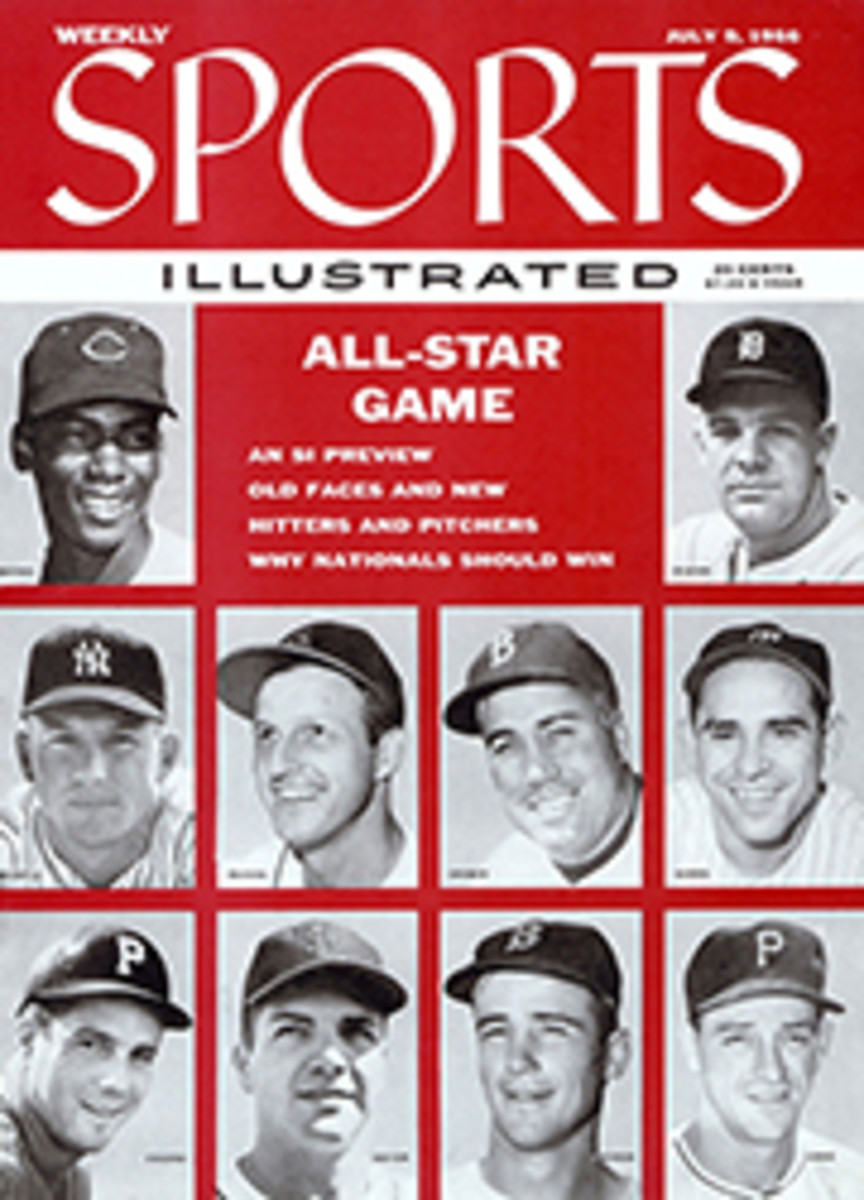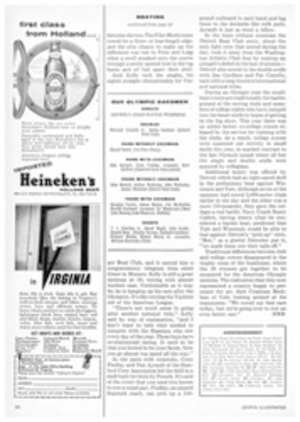
NINE YOUNG BLUES
The 1956 Olympic Rowing Trials last weekend were the grandest of them all. There were more entries, more boats and more organization than ever before. Two hundred and fifty rowers and more than 100 coaches, trainers and officials, together with a sizable number of rowing buffs, college girls and rowing-club members, piled into the Lake Onondaga grandstands for four days, augmented on the weekend by crowds of up to 10,000 from nearby Syracuse.
The meet was organized to the minute. U.S. Marines manned a ship-to-shore radio system, the press box was connected to the referee's boat, the referee's boat was connected to the finish barge, and the finish barge was connected to the boathouse. The races were broadcast to the stands from a reporting boat. Two Coast Guard boats hovered outside the course, chasing mammoth oil barges that came churning into the lake out of the Erie Canal. No unofficial boating was allowed during the races.
Most serious business of the trials came on the last day when the eight-oared shells lined up for the finals. Five of them were at their stake boats for the race that meant sudden death to the Olympic hopes of all but the winner. One by one the raised hands of the coxswains dropped to show that Yale, Cornell, Navy Officers, Washington and Wisconsin were ready. The referee raised his megaphone and the five jumped as one. Forty oars bit the water, stroked, came out and stroked again. As the boats shot down the 2,000-meter course, bow for bow at 500 meters, it was Navy by a deck over the rest. At 700 meters the shells were still even, with Washington in a slight lead. At 1,000 meter it was Yale, rowing at 32 strokes a minute. Then Cornell moved up, and the lead was passed from shell to shell in the charging wall of oars. At 1,500 meters it was Yale staving off a Cornell bid with a quick 10-stroke punch at 36, and finally, smoother than the rest, rowing at a 34 rising to a 36 at the finish, Yale moved home three-quarters of a length ahead of the pack.
The eight boats slid to a stop together while the men slumped over their oars, heaving for breath and waiting for the official word.
It came: Yale 6:33.5; Cornell 6:36.2; Navy 6:37.5; Washington 6:37.8; Wisconsin 6:40.8. Five boats across in seven seconds.
Stork Sanford took the long walk back to the boathouse, getting used to the idea that his Cornell champions had been beaten. The Navy rowed back to the dock, a great comeback story without a climax. At the dock the Yale coxswain was tossed in the water with gusto, flash bulbs snapped and the winners were bursting with talk. For four weeks now, they had been doing a slow burn. Six-tenths of a second had been the margin of their loss to Cornell at the Eastern Championship, and yet it had made them has-beens in the news as they read it.
In the four weeks spent at Gales Ferry in preparation for the Harvard race and the Olympic trials, Coach Jim Rathschmidt had welded the boys into the elusive compound that is a great crew. It showed in early workouts on Onondaga.
"They did better before the trials than they had all year," said Rathschmidt.
Captain Tom Charlton explained afterward that success was not all strength and power, "You can't just kick a guy in the tail and tell him to get in there and pull. There's more teamwork needed than in any other sport. It's more than teamwork, it's eight guys doing exactly the same thing at exactly the same time. It takes an unusual man to bring that out in a team. Someone who doesn't have to get up and wave the flag to make you want to win. It takes a coach like Jim."
Yale was not the first crew to cinch that trip to Australia. Eight-oared shells, considered the pi√®ce de résistance of the program, were served last. First was a four-oared shell with coxswain from the West Side Rowing Club that had entered as sort of an afterthought. Every one of the boys had rowed in national club championships, but as a crew they had been together just 11 days. They clicked at the last minute, and the elation of the club knew no bounds. They threw the coxswain in, and then the whole crew.
James Fifer and Duvall Hecht in the pairs without coxswain were second crew on the winner list. They came in seven lengths ahead of the 1952 Olympic champions, Charles Logg and Tom Price, in a reversal of the last race between the two. The Fifer-Hecht team rowed for a three-or four-length edge, and the slim chance to make up the difference was lost to Price and Logg when a swell sneaked onto the course through a newly opened hole in the log boom and all but upset their shell.
Jack Kelly took the singles, his eighth straight championship for Vesper Boat Club, and it earned him a congratulatory telegram from sister Grace in Monaco. Kelly is still a great oarsman at 29, rowing with almost insolent ease. Unthinkable as it may be, he is hanging up his oars after the Olympics. It's like retiring the Yankees out of the American League.
"There's not much sense in going after another national title," Kelly said by way of explanation, "and I don't want to take time needed to compete with the Russians who row every day of the year. Those boys have revolutionized racing. It used to be that you kicked in for your finish. Now you go almost top speed all the way."
In the pairs with coxswain, Conn Findlay and Dan Ayrault of the Stanford Crew Association led the field in a shell built for them by Pocock. It's said of the event that you need two horses to row a coxed pair. Findlay, an unpaid Stanford coach, can pick up a 150-pound outboard in each hand and lug them to the dockside like milk pails. Ayrault is just as stout a fellow.
In the fours without coxswain the Detroit Boat Club entry, about the only light crew that scored during the day, took it away from the Washington Athletic Club four by making up a length's deficit in the last 40 strokes—Detroit also scored in the double sculls with Jim Gardiner and Pat Costello, each with a long record of international and national titles.
During an Olympic year the small-boat events are traditionally the battleground of the rowing clubs and members of college eights who have jumped into the lesser shells in hopes of getting to the big show. This year there was an added factor: ex-college rowers released by the service for training with the clubs. As a result, college rowers were squeezed out entirely in small shells this year, in marked contrast to the last Olympic squad where all but the single and double sculls were manned by collegians.
Additional injury was offered by Detroit which had an eight-oared shell in the preliminary heat against Wisconsin and Yale. Although seven of the oarsmen had rowed 2,000-meter trials earlier in the day and the other was a mere 150-pounder, they gave the colleges a real battle. Navy Coach Rusty Callow, having drawn what he considered a harder heat, predicted that Yale and Wisconsin would be able to loaf against Detroit's "pick-up" crew. "But," as a gleeful Detroiter put it, "we made them row their tails off."
Traditional differences between club and college rowers disappeared in the trophy room of the boathouse, where the 26 winners got together to be measured for the American Olympic uniform. The realization that they now represented a country began to permeate the air. Said Coxswain Beck-lean of Yale, looking around at his teammates: "We rowed our best race today, but we're going over to row an even better one."
OUR OLYMPIC OARSMEN
SINGLES
Jack Kelly Jr. (Vesper Boat Club, Philadelphia)
DOUBLES
Bernard Costello Jr., James Gardiner (Detroit Boat Club)
PAIRS WITHOUT COXSWAIN
Duvall Hecht, Jim Fifer (Navy)
PAIRS WITH COXSWAIN
Dan Ayrault, Conn Findlay; coxswain, Kurt Seiffert (Stanford Crew Association)
FOURS WITHOUT COXSWAIN
John Welchli, Arthur McKinlay, John McKinlay, James McIntosh (Detroit Boat Club)
FOURS WITH COXSWAIN
Douglas Turner, James Wynne, Jim McMullen, Ronald Cardwell: coxswain, Ed Masterson (West Side Rowing Club Reserves, Buffalo)
EIGHTS
T. J. Charlton Jr., David Wight, John Cooke, Donald Beer, Charles Grimes, Caldwell Esselstyn, Richard Wailes, Robert Morey Jr.: coxswain, William Becklean (Yale)
ILLUSTRATION
"This is a hell of a time to get a headache."

